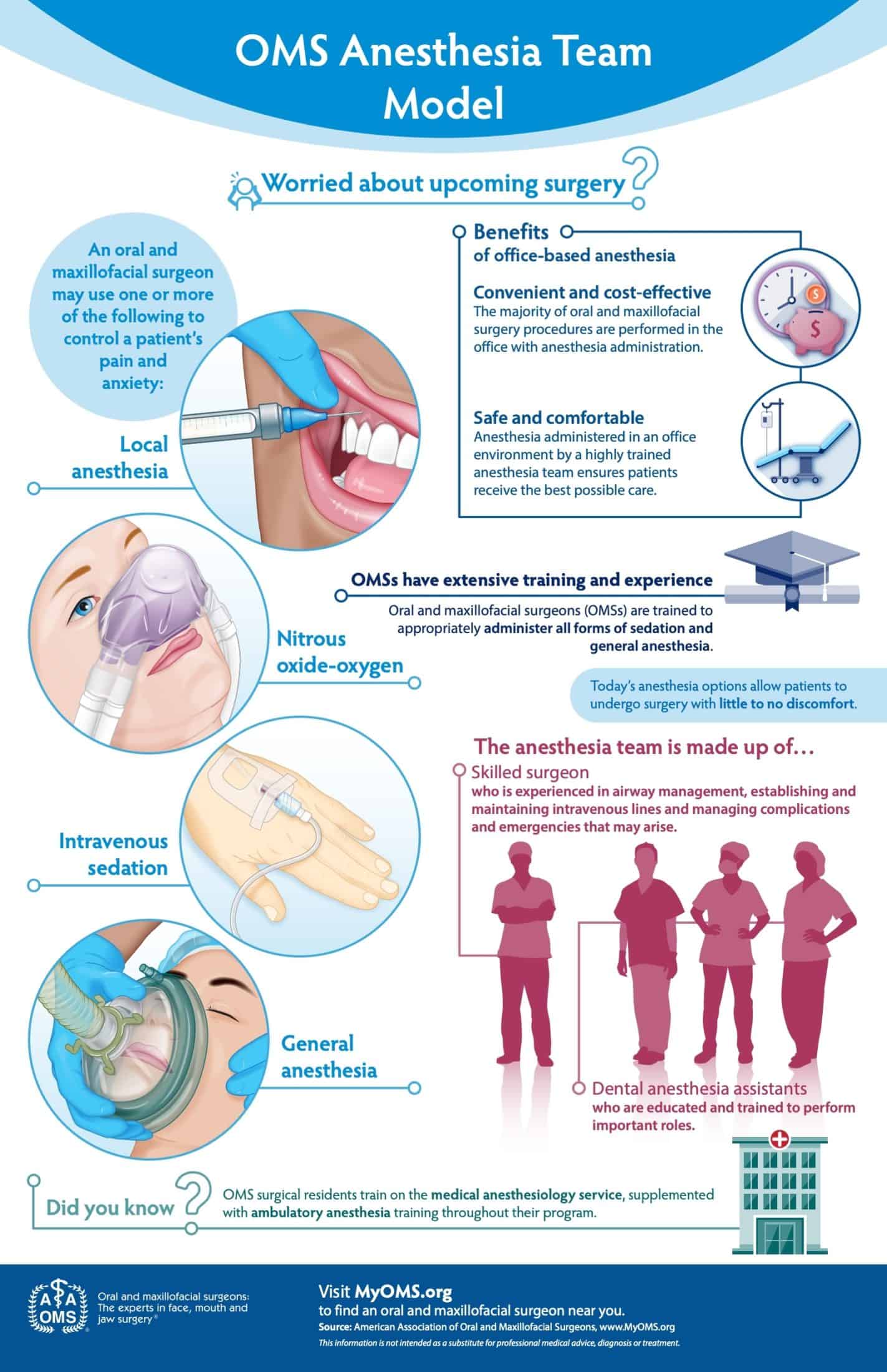Anesthesia
We Offer Several Methods of Anesthesia
Several methods of anesthesia are available. The method of anesthesia that is chosen for or by a patient depends upon the nature of the surgical procedure and the patient’s level of apprehension. The following table illustrates the choices of anesthesia, a description of the anesthetic technique, and the usual indications for that technique.
To administer general anesthesia in the office, an oral and maxillofacial surgeon must have completed a minimum of three months of hospital-based anesthesia training, and our doctors have done more than this minimal requirement. Qualified applicants will then undergo an in office evaluation by a state dental board appointed examiner. The examiner observes an actual surgical procedure during which general anesthesia is administered to the patient. The examiner also inspects all monitoring devices and emergency equipment and tests the doctor and the surgical staff competence on anesthesia related emergencies. If the examiner reports successful completion of the evaluation process, the state dental board will issue the doctor a license to perform general anesthesia. The license must be renewed at least every five years, and requires the doctor to maintain the required amount of continuing education units related to anesthesia.
Comfort Is Our Priority
Again, when it comes to anesthesia, our first priority is the patient’s comfort and safety. If you have any concerns regarding the type of anesthesia that will be administered during your oral surgery procedure, please do not hesitate to discuss your concerns with your doctor at the time of your consultation.
Local Anesthetic
The patient remains totally conscious throughout the procedure. A local anesthetic (e.g. lidocaine) is administered in the area where the surgery is to be performed. Local anesthetic is used in conjunction with the other methods of anesthesia in all oral surgery procedures.
USUAL INDICATIONS: Simple oral surgery procedures such as minor soft tissue procedures and simple tooth extractions.
Nitrous Oxide Sedation with Local Anesthetic
A mixture of nitrous oxide (laughing gas) and oxygen is administered through a nasal breathing apparatus. The patient remains conscious in a relaxed condition. Nitrous oxide has a sedative and analgesic (pain-controlling) effect.
USUAL INDICATIONS: Simple oral surgery procedures to more involved procedures such as removal of wisdom teeth and placement of dental implants.
Office Based General Anesthesia with Local Anesthetic*
Medications are administered through an intravenous line (I.V.). The patient falls asleep and is completely unaware of the procedure being performed. Medications most commonly used are Fentanyl (opiate), Versed (benzodiazepine), Ketamine, and Diprivan. Supplemental oxygen is delivered through a nasal breathing apparatus, and the patient’s vital signs are closely monitored.
USUAL INDICATIONS: General anesthesia is available for all types of oral surgery. A patient may choose general anesthesia for simple procedures depending on their level of anxiety. Most people having their wisdom teeth removed or having a dental implant placed will choose general anesthesia. General anesthesia may be necessary if local anesthesia fails to anesthetize the surgical site which often occurs in the presence of infection.
Hospital or Surgery Center Based General Anesthesia
A patient is admitted to a hospital or surgery center where anesthesia is administered by an anesthesiologist.
USUAL INDICATIONS: Indicated for patients undergoing extensive procedures such as face and jaw reconstruction and TMJ surgery. Also indicated for patients with medical conditions such as heart disease or lung disease who require general anesthesia.

Intravenous Sedation (“Twilight Sedation”)
Our office offers our patients the option of Intravenous Sedation, or to some it is referred to as “Twilight Sedation”, for their dental treatment. Intravenous Sedation or “twilight sleep” helps you to be comfortable and calm when undergoing dental procedures. Your treatment can be completed under intravenous sedation. Intravenous sedation or “IV sedation” (twilight sedation) is designed to better enable you to undergo your dental procedures while you are very relaxed; it will enable you to tolerate as well as not remember those procedures that may be very uncomfortable for you. IV sedation will essentially help alleviate the anxiety associated with your treatment. You may not always be asleep but you will be comfortable, calm and relaxed, drifting in and out of sleep – a “twilight sleep.” If you choose the option of intravenous sedation your IV sedation/anesthesia is administered and monitored by the doctor therefore eliminating the costly expense of having your treatment carried out in an operating room or same day surgical facility.
How is the IV Sedation Administered?
A thin needle will be introduced into a vein in your arm or hand. The needle will be attached to an intravenous tube through which medication will be given to help you relax and feel comfortable. At times a patient’s vein may not be maintainable, in these situations the medications will be administered and the needle retrieved – both scenarios will achieve the same desired level of conscious sedation. Once again some patients may be asleep while others will slip in and out of sleep. Some patients with medical conditions and/or on specific drug regimens may only be lightly sedated and may not sleep at all.
The goal of IV sedation is to use as little medication as possible to get the treatment completed. It is very safe, much safer than oral sedation. With IV sedation a constant “drip” is maintained via the intravenous tube.
At any time an antidote can be administered to reverse the effects of the medications if necessary. Along with IV sedation there are also other different “levels” of sedation available to you in our office.
For patients with a severe phobia or inability to tolerate the initial needle stick, an option for “breathe down anesthesia” is available. In this method a mask is applied over the patient’s mouth and nose, much like laughing gas, and slow deep breaths are taken of an inhaled anesthetic. After 30-60 seconds of breathing an anesthetic gas, the patient will slip into a state of general anesthesia (sleep). At this point an IV can be started without the patient being aware and the procedure completed. This is often a great option for young children with fear of needles.
Nitrous Oxide (Laughing Gas)
Nitrous Oxide is a sweet smelling, non irritating, colorless gas which you can breathe. Nitrous Oxide has been the primary means of relaxation in dentistry for many years. Nitrous oxide is safe; the patient receives 50-70% oxygen with no less than 30% nitrous oxide. Patients are able to breathe on their own and remain in control of all bodily functions. The patient is relaxed and may experience mild amnesia and may fall asleep not remembering all of what happened during their appointment.
Advantages
There are many advantages to using Nitrous Oxide
- The depth of sedation can be altered at any time to increase or decrease sedation.
- There is no after effect such as a “hangover”.
- Nitrous Oxide is safe with no side effects on your heart and lungs, etc.
- Nitrous Oxide is very effective in minimizing gagging.
- It works rapidly as it reaches the brain within 20 seconds. In as few as 2-3 minutes its relaxation and pain killing properties develop.
Disadvantages
Though there are no major contraindications to using nitrous oxide, you may not want to use it if you have emphysema, exotic chest problems, Multiple Sclerosis, a cold or other difficulties with breathing. You may want to ask your dentist for a “5-minute trial” to see how you feel with this type of sedation method before proceeding.

